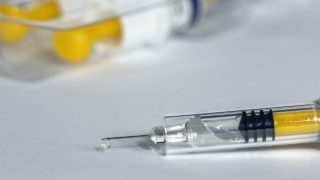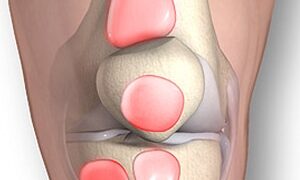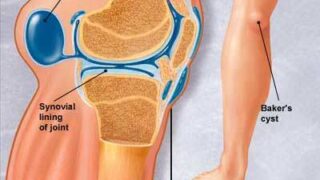Root Repair Versus Partial Meniscectomy for Medial Meniscus Posterior Root Tears
Comparison of Long-term Survivorship and Clinical
Outcomes at Minimum 10-Year Follow-up
Kyu Sung Chung,* MD, PhD, Jeong Ku Ha,* MD, Ho Jong Ra,† MD, PhD, Woo Jin Yu,* MD,
and Jin Goo Kim,ठMD, PhD
Investigation performed at Inje University Seoul Paik Hospital, Seoul, Republic of Korea
Background:
The importance of repair in medial meniscus posterior root tears (MMPRTs) has been increasingly recognized because it restores hoop tension. However, no study has compared the long-term outcomes between meniscectomy and repair.
Hypothesis:
Survivorship and clinical outcomes of repair would be better than those of meniscectomy after long-term follow-up.
Study Design: Cohort study; Level of evidence, 3.
Methods:
Between 2005 and 2009, patients with MMPRTs who had been followed up for at least 10 years after partial meniscectomy
(n = 18) or pullout repair (n = 37) were recruited. Clinical assessments, including the Lysholm score and International Knee
Documentation Committee (IKDC) subjective score, were evaluated preoperatively and at the final follow-up. The final results in each group were compared with the preoperative results, and the final results of the groups were compared. Clinical failure was defined as conversion to total knee arthroplasty (TKA), and the final clinical scores were assessed just before TKA. Kaplan-Meier survival analysis was used to investigate the survival rates of surgical procedures.
Results:
Mean ± SD follow-up period was 101.4 ± 45.9 and 125.9 ± 21.2 months in the meniscectomy and repair groups, respectively (P = .140). The mean Lysholm and IKDC scores, respectively, in the meniscectomy group were 50.8 ± 7.7 and 37.6 ± 7.0 preoperatively and 58.2 ± 22.1 and 44.4 ± 19.0 postoperatively (P = .124; P = .240). In the repair group, the mean Lysholm score
and IKDC score, respectively, significantly increased from 52.3 ± 10.9 and 41.0 ± 9.6 preoperatively to 77.1 ± 24.0 and 63.7 ± 20.6 postoperatively (P < .001; P < .001). The final Lysholm and IKDC scores in the repair group were significantly better than those in the meniscectomy group (P ¼ .004; P ¼ .003). In cases of clinical failure, 10 patients (56%) in the meniscectomy group and 8 patients (22%) in the repair group converted to TKA in the follow-up period (P = .016). According to Kaplan-Meier analysis, the 10-year survival rates for the meniscectomy and repair groups were 44.4% and 79.6%, respectively (P = .004).
Conclusion:
In MMPRTs, root repairwas superior to partialmeniscectomy in terms of clinical results for at least 10 years of follow-up.
From a long-term perspective, repair with restoration of hoop tension is more effective management than meniscectomy.
Keywords: knee; meniscus; meniscectomy; root tears; repair
背景
内側半月板後根断裂(MMPRT)における修復の重要性は、フープ張力を回復させることから、ますます認識されるようになってきている。しかし、これまでに半月板切除術と修復術の長期転帰を比較した研究はなかった。
仮説
長期追跡調査の結果、修復術の生存率と臨床転帰は切除術よりも優れていると考えられる。
研究デザイン コホート研究、エビデンスレベル 3
方法
2005年から2009年までの間に、10年以上経過観察した半月板部分切除術群( n = 18)と修復術群:Pullout repair(n = 37)を調査した。LysholmスコアおよびIKDCの主観スコアを用いて、術前と最終フォローアップ時に評価した。各群の最終成績を術前成績と比較し、各群の最終成績を比較した。Failureは膝関節全置換術(TKA)への転換と定義し、最終的な臨床スコアはTKA直前に評価した。手術手技の生存率を調べるために、Kaplan-Meier生存率分析を用いた。
結果
平均±SDの追跡期間は、半月板部分切除術群で101.4±45.9ヵ月、修復術群で125.9±21.2ヵ月であった(P = 0.140)。平均LysholmスコアおよびIKDCスコアは、それぞれ、半月板部分切除術群では術前50.8±7.7および37.6±7.0、術後58.2±22.1および44.4±19.0であった(P = 0.124;P = 0.240)。修復群では、平均LysholmスコアおよびIKDCスコアはそれぞれ、術前52.3±10.9および41.0±9.6から術後77.1±24.0および63.7±20.6へと有意に増加した(P < 0.001;P < 0.001)。修復群の最終的なLysholmスコアとIKDCスコアは、髄膜切除群よりも有意に良好であった(P = .004; P = .003)。
臨床的に失敗した症例では、フォローアップ期間中に半月板部分切除群で10例(56%)、修復群で8例(22%)がTKAに転向した(P = 0.016)。Kaplan-Meier解析によると、10年生存率は半月板部分切除術群44.4%、修復群79.6%であった(P = 0.004)。
結論
MMPRTでは、少なくとも10年間の追跡調査での臨床成績の点で、後根断裂修復は半月板部分切除術よりも優れていた。
長期的な観点からは、フープ張力の回復を伴う修復は、半月板切除術よりも効果的な管理である。

















